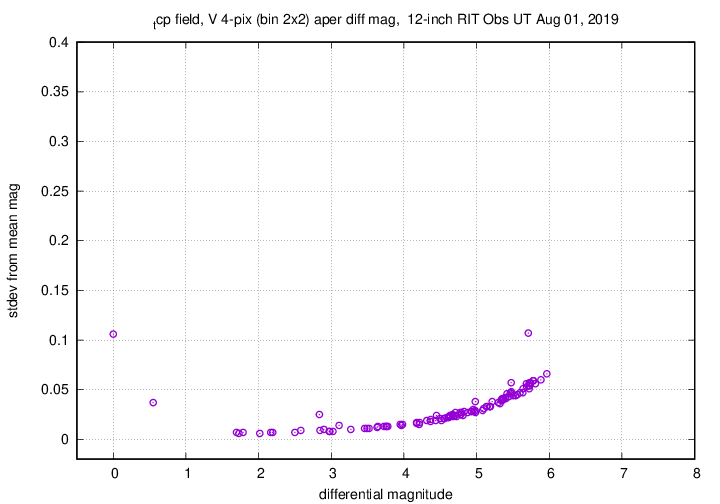
On the night of Jul 31/Aug 1, 2019, Sean Doran, Evan Muskopf, and I acquired a set of observations of the newly discovered WV Sge cataclysmic variable star TCP J21040470+4631129 (see also Astronomer's Telegram 12947 ).
The amplitude of variation has shrunk to 0.1 mag peak-to-peak now, and the mean magnitude has faded to V=11.65. I may have to increase exposure time.
RIT student Jeffrey Russell contacted me to ask if he could visit the observatory in order to look for geosynchronous satellites. He was interested in trying to detect them in photographs, as described in this article in Sky and Telescope.
We figured that the satellites ought to appear near a Declination of -6.6 degrees or so, and set up our cameras on the concrete pad. There was no moonlight, but the skies were still relatively bright. We both took a number of photographs, with a range of exposure times and lenses, but neither of us could find a trace of any geosynchronous satellites in our images. Rats. My best efforts showed trails of magnitude V = 8.5 or so, and so I would guess a motionless dot of magnitude V = 9.5 or 10 might show up ... but alas, I found no satellites.
Jeffrey combined a number of his images to create this composite, which faces South; the brightest object, at lower-right, is Jupiter. One can clearly see the Milky Way, and several meteor trails, but no geosynchronous satellites (as far as we can tell). I estimate the limiting magnitude of the trails to be around V = 7.5. The picture does a nice job of illustrating the colors of stars! (Click on the image for a full-sized version)
He also took this nice picture showing our dome and the stars in the sky behind it. Jupiter is the bright object near the bottom, with Scorpius just below it. Corona Borealis sits in the top-right corner, while Ophiuchus and Serpens occupy the middle of the picture.

The main setup was:
Notes from the night:
The object is located at
RA = 21:04:04.7 Dec = +46:31:12.9
A chart of the field is shown below. The size of the chart is about 21 by 15 arcminutes.

I've marked the location of several comparison stars, which also appear in light curves below.
star UCAC4 B V ---------------------------------------------------- A 683-095755 10.832 10.528 B 683-095722 11.142 10.948 C 683-095772 12.342 10.960 D 683-095866 12.814 12.414 E 683-095811 14.017 12.691 ----------------------------------------------------
When the telescope is pointed at the field, the finder scope's image on the television screen looks like this (North up, East left):

The dark current was a bit higher than usual -- as we worked at T = -18 C instead of the usual -20 C.

The sky value shows no evidence for clouds.

Here's a record of the telescope's drift. Note the poor performance in the second half of the night. I tried increasing aggressiveness in X from 0.1 to 0.3, but it didn't help (and I put it back to 0.1).

The number of objects detected.

I used an aperture with radius 4.0 pixels.

No sign of clouds in the image adjustment graph.

Using aperture photometry with a radius of 4 pixels (binned 2x2, each pixel is 1.34 arcsec, so a radius of 5.4 arcsec), I measured the instrumental magnitudes of a number of reference stars and the target. Following the procedures outlined by Kent Honeycutt's article on inhomogeneous ensemble photometry, I used all stars in a 600x600 pixel box around the target in each image to define a reference frame, and measured each star against this frame.
Sigma-vs-mag plots show that the floor was about 0.007 mag overall, which is good. I marked the brightest two stars in the ensemble as "variable," due to saturation.

Here are light curves of the variable and the field stars.

I used the UCAC value for the V-band magnitude of star "A" = UCAC4 683-095755 to shift the ensemble magnitudes to the standard V-band scale.
Here's a closeup of the variable and stars of similar magnitude.

You can download my measurements below. A copy of the header of the file is shown to explain the format.
# Measurements of TCPJ21040470+4631129 made at RIT Obs, UT 2019 Aug 1, # in good conditions, # by Michael Richmond, Evan Muskopf, and Sean Doran, # using Meade 12-inch LX200 and ATIK 11000. # Exposures 20 seconds long, V filter. # Tabulated times are midexposure (FITS header time - half exposure length) # and accurate only to +/- 1 second (??). # 'mag' is a differential magnitude based on ensemble photometry # using a circular aperture of radius 4 pix = 5.3 arcseconds. # which has been shifted so UCAC4 683-095755 has mag=10.528 # which is its V-band magnitude according to UCAC4. # # UT_day JD HJD mag uncert Aug01.08641 2458696.58641 2458696.58890 11.637 0.009 Aug01.08679 2458696.58679 2458696.58928 11.645 0.009
Last modified 8/01/2019 by MWR.